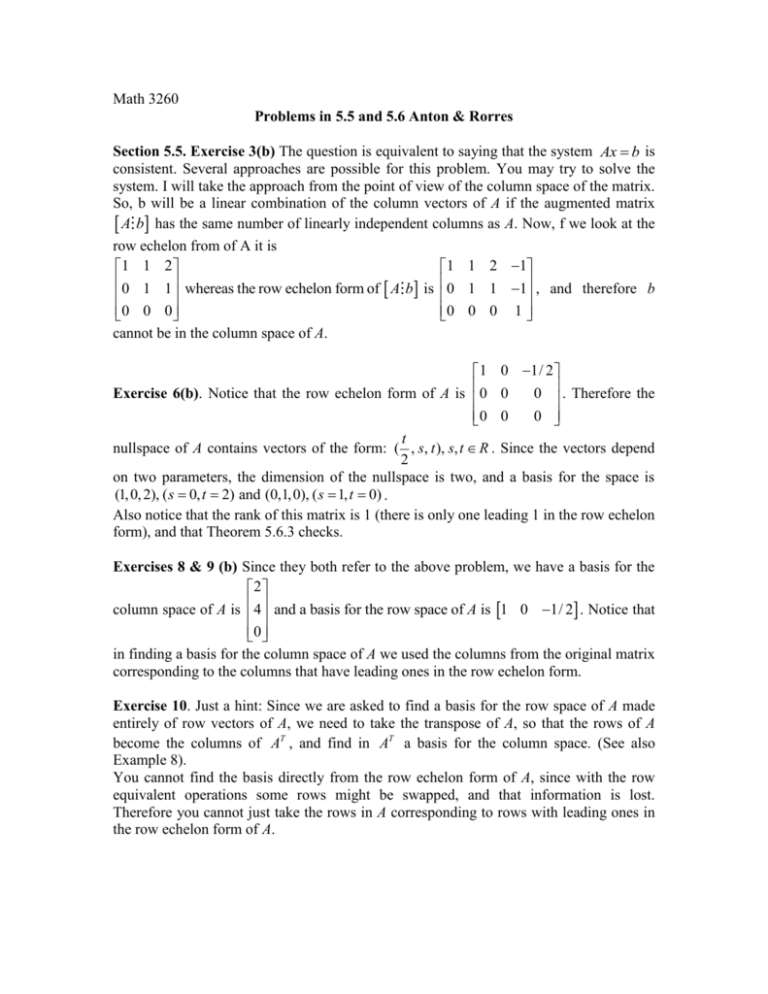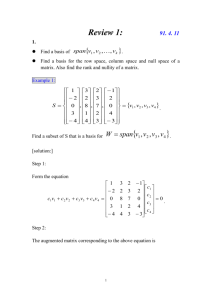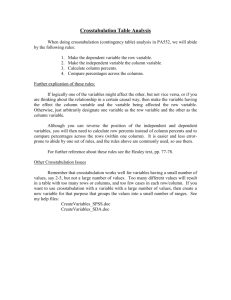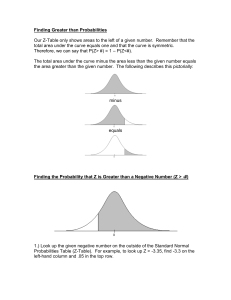Math 3260
advertisement

Math 3260
Problems in 5.5 and 5.6 Anton & Rorres
Section 5.5. Exercise 3(b) The question is equivalent to saying that the system Ax b is
consistent. Several approaches are possible for this problem. You may try to solve the
system. I will take the approach from the point of view of the column space of the matrix.
So, b will be a linear combination of the column vectors of A if the augmented matrix
A b has the same number of linearly independent columns as A. Now, f we look at the
row echelon from of A it is
1 1 2
1 1 2 1
0 1 1 whereas the row echelon form of A b is 0 1 1 1 , and therefore b
0 0 0
0 0 0 1
cannot be in the column space of A.
1 0 1/ 2
Exercise 6(b). Notice that the row echelon form of A is 0 0
0 . Therefore the
0 0
0
t
nullspace of A contains vectors of the form: ( , s, t ), s, t R . Since the vectors depend
2
on two parameters, the dimension of the nullspace is two, and a basis for the space is
(1, 0, 2), ( s 0, t 2) and (0,1, 0), ( s 1, t 0) .
Also notice that the rank of this matrix is 1 (there is only one leading 1 in the row echelon
form), and that Theorem 5.6.3 checks.
Exercises 8 & 9 (b) Since they both refer to the above problem, we have a basis for the
2
column space of A is 4 and a basis for the row space of A is 1 0 1/ 2 . Notice that
0
in finding a basis for the column space of A we used the columns from the original matrix
corresponding to the columns that have leading ones in the row echelon form.
Exercise 10. Just a hint: Since we are asked to find a basis for the row space of A made
entirely of row vectors of A, we need to take the transpose of A, so that the rows of A
become the columns of AT , and find in AT a basis for the column space. (See also
Example 8).
You cannot find the basis directly from the row echelon form of A, since with the row
equivalent operations some rows might be swapped, and that information is lost.
Therefore you cannot just take the rows in A corresponding to rows with leading ones in
the row echelon form of A.
Section 5.6. Exercise 2(d). Thanks to TI83 we find the row echelon form of the matrix
1 2 / 3 1/ 3 4 / 3 1/ 3
0
1
1
1
2
(I need to say sometimes I don’t understand TI83
R
0
0
0
0
0
0
0
0
0
0
ways, I would not expect fractions in the first row, but as you can see, it swapped the first
and second rows). We don’t have to worry, we know that the row echelon form is not
unique. Anyways, from R we see that the matrix has two linearly independent rows, and
therefore rank ( A) 2 . It follows that the nullspace of A has dimension 3 (the solution of
the homogeneous system Ax 0 has three parameters).
Exercise 10. We have to prove that the two statements are equivalent, so we need to
prove that if we assume the rank to be two, then at least one of the determinants is nonzero, and if at least one of the determinants is non-zero, then the rank of the matrix is
two.
Assume that the given matrix has rank 2. This means that its row echelon form will have
two leading ones. Now, since the entries are literal we don’t know whether a11 is nonzero
or not. However, we may assume it is not and here is the reason why. We know for sure
that we have at least one non-zero entry in the first row because otherwise the rank will
be less than 2. If a11 0 then we can swap the first column in A with a column in which
the entry on the first row is non-zero. Notice that although this is not a row equivalent
operation, the determinants we have to consider will change at most in sign. This means
that if we can prove that at least one of the determinants in the problem, with columns
possibly interchanged is not zero then we are done.
Therefore, let us assume that a11 0 . By dividing the first row by a11 , we will get the
first leading one. Then, after getting zero on the first column in the second row, we move
on to find the first nonzero entry. Since the rank is 2, either the entry on the second
column or the third column is not zero. Assume that the entry is in the second column.
a
That entry will be a22 a12 21 0 a22 a11 a12 a21 0 . But this last statement is
a11
a11 a12
0.
a21 a22
Conversely, let us assume that at least one of the determinants is non-zero. If the rank of
the matrix were not two, it must be one (since it cannot be greater than two). But thenit
will follow that the two rows of the matrix are multiples of each other. If this is the case,
then all determinants of order two formed with the elements of the matrix will be zero,
but this contradict our hypothesis. Therefore the rank has to be two.
equivalent to
Exercise 10(a). This is a very nice problem. First, notice that the sum of two even
polynomials is an even polynomial, and a constant multiple of an even polynomial is still
an even polynomial. Therefore the set is a subspace of the space of polynomials of order
at most n.
Now to find a basis, we start with a general polynomial of degree n:
p( x) a0 a1 x a2 x 2 ... an x n . Since p( x) p( x), for all x , it follows that all
coefficients of odd powers of x are zero. Therefore, a basis in the subspace of even
polynomials is {1, x 2 ,..., x n }, if n is even, and {1, x 2 ,..., x n1}, if n is odd.
Exercise 13. Luckily, things don’t look too bad. We already have a leading one in the
first row and a zero in the first column of the second row. Now we move to the second
entry, r 2 .
If r 2 0 , then we can get a leading one in the second row and independent of the
value of s, we have a nonzero value in the third row, so the rank ( A) 3 .
If r 2 0 , we move on to the third row. If s 1 0 , then as before, rank ( A) 3 .
If r 2, and s 1 , then there is no leading one in the second column, so we are left with
the nonzero entry in the third column, so rank ( A) 2 .







